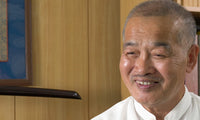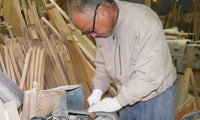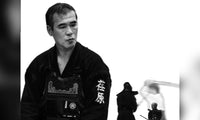The hakama is not meant to hide the footwork
The hakama: simple clothing of the nobility
The hakama serves to hide the movement of the feet in the practice of martial arts, and in Aikido in particular?
It is such a common explanation that it has almost become a truth for practically all practitioners. Unfortunately, it is false, and this is very easily demonstrated when we look at the history of this garment, how it was and how it still is worn in Japan.

Reconstruction of a ceremony in in the Kamakura period - The Kagami biraki (2017)
The hakama, affair of the samurai?
The hakama is seen in the West as the typical clothing of the samurai. Now, the hakama is originally a ceremonial garment, worn by the nobility but also by the clergy.
In Japan, still today, the hakama is more emblematic of graduation, marriage and other religious ceremonies than samurai and martial arts, although it remains omnipresent, particularly in the practice of Kendo.
The hakama being found in China, at a period prior to its appearance in Japan, it is very likely that it was imported to Japan within Buddhism, making this outfit a formal ceremonial garment.
It is true that the samurai wore hakama. It was not always the case and it seems that one of its debuts in this environment was a thicker garment, even leather, worn on horseback to protect oneself from branches and brambles.
This is also the point where the two types of hakama "andon" and "umanori" can be explained. Andon features the traditional "lantern" shape (or skirt-like cut), and umanori literally means "ride a horse" and is hence, cut in the shape of trousers.
Indeed, although the monks and women had no reason to ride horses, the samurai and nobles did. They needed a garment that allowed them to spread their legs and thus, that was most likely the origin of the umanori shaped hakama. It is difficult to find prove the further we travel back in time, however, it is therefore also very likely that the andon hakama preceded the umanori hakama.
The wearing of relatively short hakama is evident in ancient Koryu such as the Tatsumi Ryu featured in the video above.
The meaning of the hakama for the samurai
To summarize, the Hakama is not specifically an affair of the samurai, but it rather was a commonly used garment. Let us pass on to its use in horse riding, very far from the hakama that we know today, and move on from there to the reasons why the samurai wore a hakama made from cloth.
The hakama actually was a formal garment. It was worn with a traditional kimono whose ensemble forms the Kamishimo and it used to demonstrate rather a social status than the status of a warrior. This uniform was indeed worn by the vast majority of the nobility as well as by the wealthy merchants.
There were also other types of hakama worn depending on the ceremonies, in particular a very long hakama called "nagabakama", hampering severely the movement. It is very likely that in the warlike society of the time, the demand on visitors (samurai) to wear that type of hakama by some seigneurs and Shogun was a precautionary measure to prevent them to move (and attack) easily.

A hakama worn under the armor by men on the right, and quite short on the left by women
As far as everyday wear was concerned, there are two types of use
The one that one sees very often in samurai movies, setting in scene a ronin (samurai without master), confronted with unexpected attacks or duels. In such sequences, the samurai is often in his daily clothes and ties the legs of his hakama and the sleeves of his kimono to facilitate his movements.
And the second is the war. The upper echelons who did not concede at the front eventually wore the hakama, but most warriors were wearing armors and the hakama made no longer sense.
Bokken duel in one of the most beautiful samurai color films: Ame Agaru. Notice that the hakama worn by both protagonists are rather short.
That being said, you will find quite interesting that Samourais in old movies such as Akira Kurosawa's movies are wearing their Hakama very short, while in modern Jidai geki (movies) shot the past 10 or 20 years, the Hakama are much longer. Obviously, fashion has also taken over the historical movie industry !
The way of wearing the hakama - and showing the feet
On prints of that time, but also via the traditions preserved in certain schools, it is very clear that the hakama is worn above the ankle on one hand, and that it sometimes even is attached during duels and fights.
At this point, it gets very difficult to justify the fact that a hakama serves to hide the footwork. Would you hide your feet at the risk of hindering your movement, slowing you down and thus dying? Would you show your feet during a duel, witnessed by spectators, but hide them during training in the dojo? This is very unlikely.

Drawing of that time, the Hakama worn short (bottom/right)
It is not impossible that there were samurai who wore the hakama to hide the movement of the feet and not to reveal their techniques. However, if this was the case, they had to be certain that this would not cause a significant disadvantage in terms of freedom of movement and it also presupposed that they indeed had a "secret" technique not to be disclosed.
And particularly in that context, it has to be mentioned that in general, the samurai were actually not all very good at fighting.
Representing 7% of the population during the Edo period, they were part of the caste of the nobles and managed mainly administrative affairs or military strategy.

Print of that time, the Hakama worn very short
What about these days? Is it to hide the movement?
Hiding the feet movements from ones students being there to learn, or hiding ones footwork from the teacher being there to correct us - wouldn't that be a funny choice?
There is certainly an aesthetic side to wearing the hakama relatively long, and it has become a fashion, but it is not a tradition that historically makes sense.
In this video, Tada Shihan wears the hakama relatively short, wedging it into his belt at 1:06 approximately, to facilitate his movements and to show what he demonstrates. What is the interest in having a long hakama for aesthetic reasons if it is to pull it up especially during demonstrations?
Tada Hiroshi Shihan during the 51st All Japan (2013)
Of course, this is not to advise you to wear the hakama short. It is a personal choice. However, if you make this choice, do it knowingly and not based on false beliefs.
Good practice to all!
Further information: Why do Yudansha wear Hakama? by Guillaume Erard. Excellent article on the meaning of the hakama in the practice of martial arts.






9 comments - The hakama is not meant to hide the footwork
Hello! I’m struggling to find some guide that shows how some hakama (and yukata) are pulled up, like it was meant to avoid puddles. Do you know or have some material about this? I think it’s probably simply, but I couldnt find.
Thanks for this info, even after many years the post is very helpful. Also there is another myth that fall because of these article: The 7 folds of the Hakama is the seven virtues of the samurai.
Thank you for the interesting article(s) on the history of the Hakama. The Hakama may not have hiding the feet as an intended historical reason for its existence, but there’s no denying that the traditional Aikido Hakama does indeed hide the feet, and quite well at that, giving the beautiful floating appearance and does make it harder for an adversary to know what the Aikidoka is doing. But it is for this very reason, we are told as Tomiki or Shodokan Aikido practitioners, that we do not wear the Hakama, even our shihan. Kenji Tomiki was an educator, a professor. He wanted us to see his and our instructors foot work at all times, and for senseis to see the student’s. Tomiki was, of course, a highly established Judoka when Jigoro Kano suggested he go and study with his friend, Morihei Ueshiba’s new Aiki-jutsu art that Kano was very impressed with. So, of course, as a Judoka Tomiki was used to his practice without a Hakama and this surely also had something to do with why Tomiki didn’t require Hakama with his students.
In reply to SUNG Ju-hwan.
Hi,
Thank you for your comment!
Sure, no problem, you can translate in any language (except English, Japanese and French), as far as you link back to us.
Wish you the best on the mats!
Thank you for this article! I was looking for some serious informations on this topic recently and I’m glad that now I understand Hakamas’ origin and purpose. I’m not wearing one yet, since I’m the second kyu now (Aikido), but I know that the length of the Hakama is the never ending topic among every Aikido practitioners around the world.
In reply to Jan Kovarik.
Hi Jan,
Thanks for your comment.
Yeah, it’s one of the main Aikidoist’s fad, but it’s a light topic to be honest
Thank you for the article. I’ve also had the same interest on this topic, but you solved it. I translated it into Korean and uploaded on my blog for my fellow Aikidokas. Of course I put the address of the original text together. If it’s not allowed, I will put it down.
Thank you again.
Thank you for the article. Lot’s of good information. I am a member of a local Aikido Dojo, but I don’t practice Aikido. I practice Iaido. My Sensei advised me that the hakama should in fact cover ones feet. One of the reasons he stated for a longer hakama, is that it teaches one to shuffle ones feet during movement. Not sure if this is only refers to Iaido, or if the length of the hakama is specific to the dojo or which Budo you practice. For sure, it’s much more aesthetically pleasing. :^)
In reply to Domingo Villanueva.
Thanks for your comment.
We can’t talk for that specific school.
At the end, it’s the teacher’s call and as far as it’s not justified by false historical facts, then it seems a totally legit explanation.
All the best !